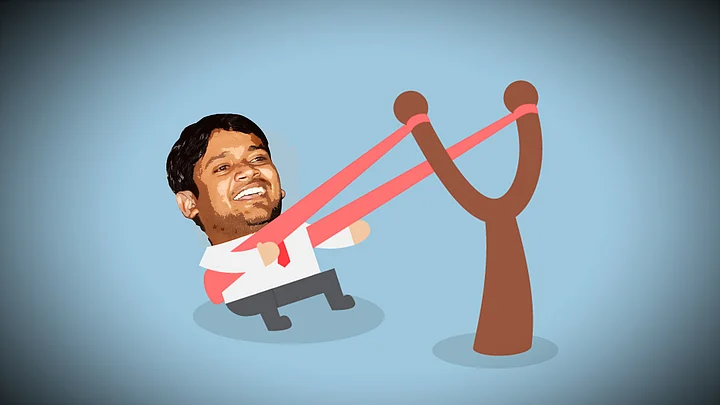Last week, a BJP leader told me how well the ‘national-vs-anti-national’ campaign was going – till the administration decided to crack down on Kanhaiya Kumar, leader of the students’ union at the Jawaharlal Nehru University (JNU).
The rest of the story is now part of popular folklore – Kanhaiya was charged with sedition, beaten by thuggish lawyers in court with cops standing inert, he finally got interim bail and came back to campus. Then he delivered a speech, remarkable for its erudition, subtle dramatics – a powerful sermon against forces of stifling authority – all laced with a smile and a terrific sense of humour.
His speech was among the finest in Indian political history, and in this day of instant media communication and restless youth straining against joblessness but hooked to social media, a global online sensation.
Now, Kanhaiya, a member of AISF, the students’ union of the Communist Party of India (CPI), is a national star. TV news channels – dad’s medium according to our kids, who get their stuff off the internet – struggle to get a few minutes with him.

Dashing Hopes of a Comeback
Alarmingly for everyone pushing a different agenda, Kanhaiya might participate in election rallies for the Left in Bengal, which faces a mammoth, six-phase campaign from 4 April to 5 May 2016. The Trinamool Congress (TMC), led by the autocratic Mamata Banerjee, was expecting a free ride back to power. Those hopes are tarnished by two factors.
One is a tactical alliance between the Left and Congress, which got, 40 percent and 9 percent of the vote respectively in the last assembly poll in 2011. Together, that was much more than the TMC’s 39 percent vote share, but the latter still won overwhelmingly because the opposition votes were widely scattered, while TMC votes were concentrated.
To offset that, Banerjee has been playing footsie with the BJP for some time, offering a tacit understanding that could enable the ruling party at the Centre, a toehold in Bengal, where it has a solitary MLA. The BJP fancies that it can foray into Bengal, simply because its share of votes quadrupled to 17 percent in the Lok Sabha polls in 2014.
But it could be mistaken: the increase of votes came at the cost of small Left parties like the Forward Bloc, RSP and so on, but didn’t significantly belong to the core CPI(M) vote base, which is still around 23 percent of the total. Add to that the Congress’ steady 9 percent-plus, which it maintained in 2014, the total is dangerously close to TMC’s 39 percent.
Why Is TMC Anxious?
- Mamata’s comeback
in West Bengal will be difficult if the Left
and Congress join hands.
- Didi’s attempts
to woo BJP have not been fruitful.
- TMC suffers from five
years of anarchic rule by Banerjee in the state.
- With 20 percent of
Bengal’s electors being first-time voters, the Kanhaiya factor can spoil the TMC’s chances.

Didi’s Dilemma
The TMC suffers from five years of whimsical, anarchic rule by Banerjee, the sole netri (leader) of her party. There are no other leaders in her party. A minister I spoke to more than a year after the TMC came to power, said he was willing to talk about the failures of the earlier Left regime. But what about the TMC’s own plans and performance?
“Oh no, no, Dada,” he said, genuinely horrified, “Only Didi knows and she can talk about that.” There ended that conversation.
Till recently, TMC, which had inherited the Left’s goon squad lock-stock-two smoking barrels-plus-motorcycle, could count on coercion and the helplessness of opposition organisations, to sweep to power. But since December, when rumours of a Left-Congress alliance surfaced, Didi is less sure of winning hands down.
Hence, she has called back Mukul Roy,
the chain smoker organisational genius of TMC, who she had banished to vanvas over some perceived
‘transgression.’ Hence, the resurrection of Madan Mitra, a former minister,
accused in the Saradha scam, who served more than a year in jail. Mitra has now
got the ticket to contest polls from Kamarhati.
In all this, the prospect of a Kanhaiya whirlwind supporting the Left in Bengal, is terrible news for Didi. Kanhaiya is now a national phenomenon. He stands for the youth, whose hallmark is to rebel against authority.

The Youth Factor
Didi and her administration, unfortunately, have been liberal with police lathis on students agitating for their rights from Calcutta’s elite Presidency College and Jadavpur University, to regional universities in Burdwan and Kalyani.
Around 20 percent of Bengal’s electors will be first time voters, between 18 and 23 years old. Most are students – almost all are Kanhaiya fans. This is a terrifying prospect for Didi and the BJP – and a canister of oxygen for the geriatric Left leaders of Bengal.
The BJP leader mentioned earlier shook his head and said, “Look, it was all going so well. But the administration botched it up. From thin air, we created an overnight national hero.” Of course, he was talking about Kanhaiya.
(The writer is a Delhi-based senior journalist)
(At The Quint, we question everything. Play an active role in shaping our journalism by becoming a member today.)
